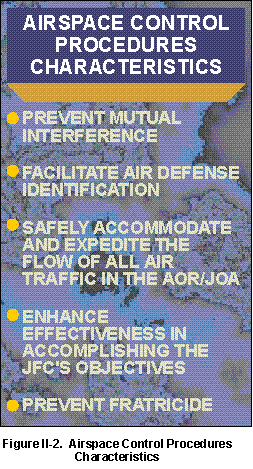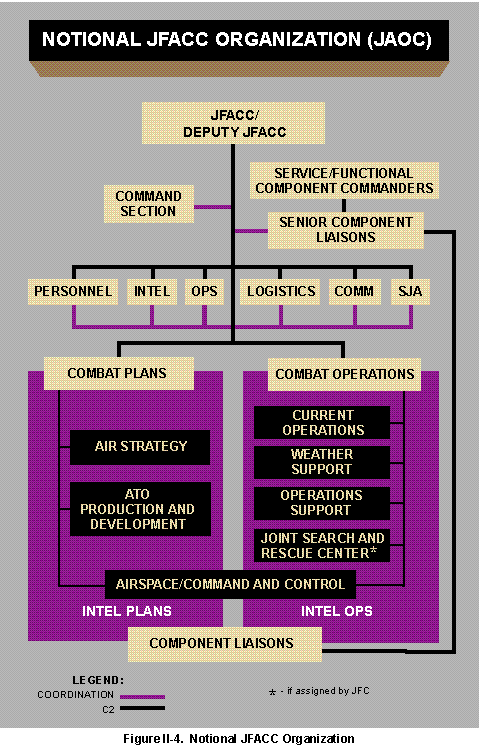
AV-8 Aircraft
GENERAL CONSIDERATIONS FOR COMMAND AND
|
"Air power is indivisible. If you split it up into compartments,
you merely pull it to pieces and destroy its greatest asset --
its flexibility."
Field Marshal Montgomery |
1. Air Effort Available for Joint Air Operations
The air capabilities/forces made available for JFACC or JFC (under the JFC staff option) planning and tasking are determined by the JFC, in consultation with component commanders, and based on the assigned objectives and the concept of operations.
a. Component commanders make capabilities/forces available to the JFC for tasking to support the joint force as a whole based on assigned component missions and JFC guidance. These capabilities/forces are tasked directly by the JFC or by the JFACC based on the JFC's air apportionment decision.
b. Only the JFC has the authority to reassign, redirect, or reallocate a component's direct support air capabilities/forces. When a component does not have the organic air capabilities/ forces to support their assigned mission, the JFACC or JFC will task available joint air capabilities/forces (through the joint ATO) based on the JFC's air apportionment decision. An understanding of what defines component direct support air capabilities/forces and joint air capabilities/forces is necessary. Component direct support air capabilities/forces are those air capabilities/forces organic to a component that are used by the component to accomplish its assigned mission. When appropriate, they appear on the joint ATO for coordination and deconfliction purposes.

AV-8 Aircraft
c. Component capabilities/forces not available for joint air tasking must still comply with the airspace control order (ACO) and special instructions (SPINS). 2. Designation of a JFACC
The JFC will normally designate a JFACC. The JFC will base the decision to designate a JFACC on several factors such as: JFC's overall mission, concept of operations, the missions and tasks assigned to subordinate commanders, forces available, duration and nature of joint air operations desired, and the degree of unity of command and control of joint air operations required. The JFC will normally assign JFACC responsibilities to the component commander having the preponderance of air assets and the capability to plan, task, and control joint air operations.
3. JFACC Authority and Command Relationships
The authority and command relationships of the JFACC are established by the JFC. These typically include exercising operational control (OPCON) over assigned and attached forces and tactical control (TACON) over other military capabilities/forces made available for tasking. The JFC may also establish supporting and supported relationships between components to facilitate operations. The JFC normally assigns missions and issues mission-type orders to all components. With receipt of the mission goes the authority to conduct operations in accordance with the JFC's intent and concept of the operation.
The responsibilities of the JFACC are assigned by the JFC. These include, but are not limited to: planning, coordination, allocation, and tasking of joint air operations based on the JFC's concept of operations and air apportionment decision. Specific JFACC responsibilities normally include (also shown in Figure II-1):
Developing a joint air operations plan to best support joint force objectives as assigned by the JFC or higher authority.
Recommending to the JFC apportionment of the joint air effort, after consulting with other component commanders, by percentage and/or by priority that should be devoted to the various air operations and/or geographic areas for a given period of time.
Providing centralized direction for the allocation and tasking of capabilities/forces made available based on the JFC air apportionment.
Controlling execution of joint air operations as specified by the JFC, to include making timely adjustments to targeting and tasking of available joint capabilities/forces. If circumstances require the JFACC to change the planned joint air operations during execution, the JFACC will notify the affected component commanders or JFC, as appropriate.
Coordinating joint air operations with operations of other component commanders and forces assigned to or supporting the JFC [e.g., combat search and rescue (CSAR) operations, the joint force special operations component commander (JFSOCC), and if designated, the joint special operations air component commander (JSOACC) for integration, synchronization, and deconfliction with special operations].
Evaluating the results of joint air operations and forwarding combat assessments to the JFC to support the overall combat assessment effort.
Performing the duties of the airspace control authority (ACA), when assigned that responsibility by the JFC.
Performing the duties of the area air defense commander (AADC), when assigned that responsibility by the JFC.
Functioning as the supported commander for:
- Strategic attack operations, when joint air operations constitute the bulk of the capability needed to directly attack enemy strategic centers of gravity.
- Theater airborne reconnaissance and surveillance.
- The JFC's overall air interdiction effort.
- Interdiction target priorities within the land or naval force areas of operations (Aos) are designated by the land and naval component commanders.
- These priorities are considered along with the JFC's AOR/JOA-wide interdiction priorities and reflected in the air apportionment decision. The JFACC will use these priorities to plan and execute the AOR/JOA-wide interdiction effort.

5. Airspace Control Considerations and the JFACC/ACA/AADC Relationship

The responsibilities of the JFACC, ACA, and AADC are interrelated and should normally be assigned to one individual. The functions and responsibilities of the JFACC, ACA, and AADC must be integrated in order to unite joint air operations with joint airspace control and joint air defense operations in support of the JFC's campaign. Designating one component commander as JFACC, AADC, and ACA may simplify coordination required to develop and execute fully integrated joint air operations. If conditions do not permit this assignment, then close coordination between all three positions is essential. Joint Pub 3-52, "Doctrine for Joint Airspace Control in the Combat Zone," provides further guidance on the AADC and ACA.
If appointed the ACA, the JFACC is responsible for developing, coordinating, and publishing airspace control procedures and for operating the airspace control system in the AOR/JOA. Characteristics of procedures used to deconflict in time and space, coordinate and integrate the activities of all users of airspace (including fixed- and rotary- winged aircraft) are shown in Figure II-2.
All missions are subject to the ACO of the ACA: however. centralized direction by the ACA does not imply OPCON or TACON over any air assets.

Methods to accomplish this deconfliction, coordination, and integration vary throughout the range of military operations from war to MOOTW that include both combat and noncombat activities. The methods range from positive control of all air assets in an airspace control area to procedural control of all such assets with any effective combination of positive and procedural control between the two extremes. Figure II-3 shows the characteristics of the two methods. It is up to the JFC, through the airspace control plan (ACP), to decide the appropriate method based on the concept of operations.
MOOTW in a Transitional Environment. Depending on the environment, mission, and location throughout the range of military operations, the degree of control may need to be rigorous and the rules of engagement (ROE) may be more restrictive. This is especially true in a MOOTW environment that can transition quickly from combat to noncombat and back again and often has constraints on the forces, weapons, tactics employed, and level of violence. Consequently, as a minimum, in MOOTW environments prone to such fluctuations, all air missions, including both fixed- and rotary- wing of all components, must appear on the appropriate ATO and/or flight plan. In addition, all aircraft must monitor a common frequency and operate on designated identification, friend or foe (IFF) modes and codes, which must be appropriately checked prior to mission start. In cases of high density aircraft operations, such as in a properly designated high density airspace control zone (HIDACZ) or amphibious objective area (AOA), published on the ACO, aircraft may operate without an ATO mission number. This type of rigorous control is necessary during such MOOTW because the mix of friendly, enemy, and neutral aircraft and mission constraints require the JFC to strictly control flights in the AOR/JOA (e.g., peace operations). No matter what methods the JFC chooses, they need to be continually evaluated for effectiveness and efficiency as the environment and mission change. For a full discussion of the methods of and responsibilities for joint airspace control throughout the range of military operations, see Joint Pub 3-52 "Doctrine for Joint Airspace Control in the Combat Zone."
Figure II-4 represents a notional JFACC organization. The JFACC's operations center will often be designated a joint air operations center {JAOC).

Each of these JAOC organizations rely on expertise from other component liaisons (e.g., battlefield coordination element (BCE), naval and amphibious liaison element (NALE), Air Force liaison element (AFLE), special operations liaison element (SOLE), air mobility element (AME), strategic liaison team (STRATLAT), space liaison officer (SLO), Marine liaison officer (MARLO)) to coordinate requests or requirements and maintain an "up-to-date" picture of the other component operations.
Finally, the role of "intelligence" is extremely important and is an integral part of the daily function of Combat Plans and Combat Operations. Intelligence personnel monitor and assess adversary capabilities and intentions and provide assistance in target, weapon, and platform selection, conduct battle damage assessment, as well as, provide an "up-to-date" picture of the adversary, expected adversary operations, and the status and priority of assigned targets to assist in execution day changes.
|
"Once the command of the air is obtained by one of the contending
armies, the war must become a conflict between a seeing host and
one that is blind."
H.G. Wells |
The components have ready access to the JFACC and staff through the component liaisons. These liaisons work for their respective component commanders and work with the JFACC and staff.
Coordination Elements. Each component normally provides liaison elements (BCE, NALE, SOLE, and others as appropriate) that work within the JAOC. These liaison elements consist of experienced warfare specialists who provide component planning and tasking expertise and coordination capabilities. These experts help integrate and coordinate their component's participation in joint air operations (e.g., special operations force (SOF)) and coordinate and deconflict component direct support air operations with joint air operations. (See Appendix B , "Liaison Elements Within the JAOC".)
The JFACC's staff should be organized and manned so that component representation reflects the composition of the joint force. This representation will provide the JFACC with the expertise needed to effectively employ the capabilities/forces made available. Functional component staffs require advanced planning for efficient operations. JFACC staff billets for needed expertise and individuals to fill those billets should be identified. Such individuals should be identified and trained during peacetime and used when JFACC staffs are formed for exercises and actual operations to ensure an effective transition to combat operations. JFACC staffs should include appropriate component representation at all levels.
Preparation. For each specific operation, the nucleus of the JFACC staff should be trained in JFACC operations and be representative of the joint force. Staff augmentation with manning as identified above ensures joint representation throughout the JFACC's staff and JAOC. The JFACC, in coordination with other component commanders, will determine specific manning requirements based on scenario requirements, force list, and personnel availability.
Procedures for joint air operations are designed to exploit the flexibility of air power to achieve joint force objectives while providing support to component operations. Joint air operations scenarios may vary, and each scenario requires extensive planning when transition of JFACC responsibilities is necessary.
Assignment of Sea-based JFACC. The JFACC should be seabased when any one of the following conditions are present:
- land-based facilities or sufficient infrastructure does not exist,
- a secure land-based area is not available, or
- ground support forces are forced to withdraw.
- Unplanned Transition. During unplanned shifts of JFACC responsibility, as a possible result of battle damage or major command and control equipment failure, a smooth transition is unlikely. Therefore, the JFC should predesignate alternates (both inter- and intra- component) and establish preplanned responses/options to the temporary or permanent loss of JFACC capability. Frequent backup and exchange of data bases is essential to facilitate a rapid resumption of operations should an unplanned transition be required.
- Transition Events. The following are events that may cause the JFACC responsibilities to shift:
- Buildup or relocation of forces shifts preponderance of air assets to another component commander and the JFC decides that the other component is in a better position (location, C2 capability, or other considerations) to accomplish the JFACC responsibilities.
- Command, control, communications, computers, and intelligence (C4I) capability to support the current JFACC becomes unresponsive or unreliable.

There may be situations where designation of a JFACC is not required. Typically, this would occur when a conflict or situation is of limited duration, scope, and/or complexity. Unity of effort, centralized planning, and decentralized execution of air capabilities/ forces would still be of primary importance to the JFC. In cases where a JFC does not designate a JFACC, the JFC may elect to directly task joint force air capabilities/forces. If this option is exercised by the JFC, the JFC's staff will assist in planning and coordinating air operations for JFC approval. The JFC may elect to centralize selected functions (planning, coordinating, and tasking) within the staff to provide direction, control, and coordination of the capabilities and/or forces assigned to the joint force.
- When joint air operations are the only operations or the duration and scope of air operations are of a very limited nature, the JFC may elect to plan, direst, and control joint air operations. The JFC's staff will assist in coordinating joint air operations.
- Once the JFC issues a mission-type order and provides his intent, subordinate commanders make decisions based on the JFC's concept of operations and the desired end state.
The JFC staff derives its authority from the JFC, who delegates authority and assigns responsibilities based on the estimate of the situation. JFC staff authority, relationships, and responsibilities must be specified early in the planning process. The JFC may delegate authority and assign responsibility for coordinating joint air operations to a staff division (e.g., J-3 Operations), a specific staff officer in a staff division (e.g., J-3 air officer), or to a special staff. Authority and responsibility for joint air operations does not automatically include joint airspace control and air defense. Though normally assigned to one individual, the JFC may assign separate authority and responsibilities for joint airspace control and air defense operations.
Coordination. The JFC staff coordinates joint air activities with other operations in the AOR/JOA. As appropriate, component commanders, supporting commanders, and coordinating agencies furnish liaison elements and augmentees to the JFC staff to coordinate their actions with the joint forces as a whole.
Execution. The JFC staff monitors and directs the execution of joint air operations tasked through the joint ATO. This may include redirecting sorties, as directed by the JFC, to accomplish joint force objectives.
Joint Airspace Control. The JFC staff may be tasked to coordinate and integrate the use of airspace in the AOR/JOA. If tasked with joint airspace control, the JFC staff develops the ACP. The ACP is implemented through the ACO. For more information, see paragraph 5 and Joint Pub 3-52, "Doctrine for Joint Airspace Control in the Combat Zone."
Joint Air Defense. The JFC may task the staff to coordinate and integrate joint air defense operations within the AOR/JOA. If tasked with coordinating joint air defense, the JFC staff recommends joint air defense priorities and develops the joint air defense plan.
Supporting Operations. Joint air operations may require support (e.g., suppression of enemy air defenses, ground based air defense) from resources other than aircraft. The JFC may direct components to support joint air operations with assets, capabilities, or forces, in addition to the air capabilities/forces provided.
The JFC staff should be organized and manned so that component representation reflects the composition of the joint force. The JFC staff operates out of the joint operations center (JOC). Under the JFC staff option, the JOC also functions as the JAOC. From the JAOC, the JFC staff plans, monitors, and directs the execution of joint air operations for the JFC. JFC staff manning should include expertise necessary to plan and execute joint air operations. These staff billets and personnel should be identified and trained to be effective in combat operations. See Joint Pub 0-2, "Unified Action Armed Forces," Joint Pub 3-0, "Doctrine for Joint Operations," and Joint Pub 5-00.2, "Joint Task Force Planning and Guidance Procedures," for more information on joint staffs.
13. Transition Between JFC Staff and JFACC
The JFC may assign C2 of joint air operations to a JFACC when the duration and scope of joint air operations exceed the JFC's span of control. Additionally, the JFC may transfer designated mission experts and functional area augmentees from the JFC staff to the JFACC's JAOC to assist in the transition and coordination of joint air operations. Conversely, a transition from JFACC to JFC staff may also be directed when the JFC determines that joint air operations are no longer of the size and scope to warrant a JFACC.